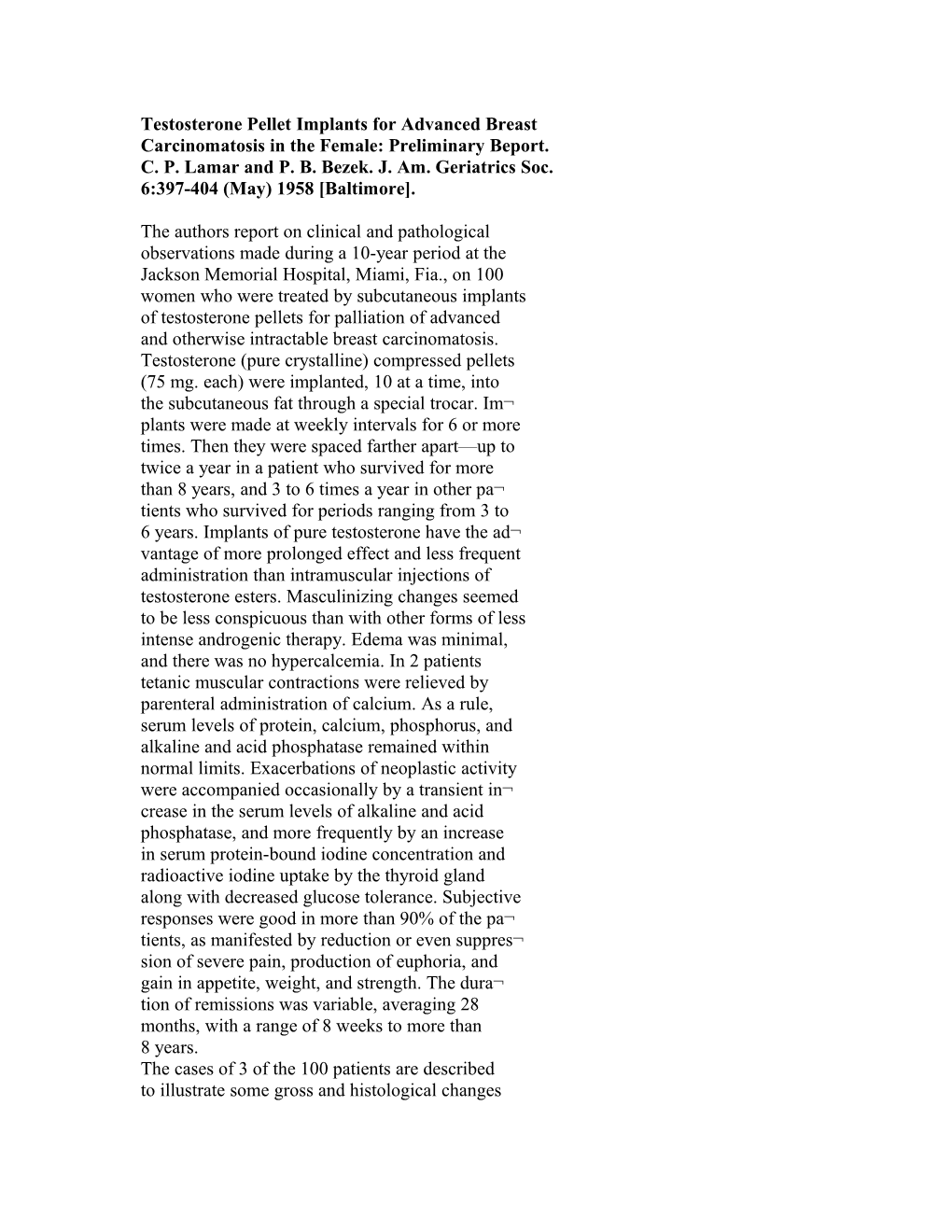Testosterone Pellet Implants for Advanced Breast
Carcinomatosis in the Female: Preliminary Beport.
C. P. Lamar and P. B. Bezek. J. Am. Geriatrics Soc.
6:397-404 (May) 1958 [Baltimore].
The authors report on clinical and pathological
observations made during a 10-year period at the
Jackson Memorial Hospital, Miami, Fia., on 100
women who were treated by subcutaneous implants
of testosterone pellets for palliation of advanced
and otherwise intractable breast carcinomatosis.
Testosterone (pure crystalline) compressed pellets
(75 mg. each) were implanted, 10 at a time, into
the subcutaneous fat through a special trocar. Im¬
plants were made at weekly intervals for 6 or more
times. Then they were spaced farther apart—up to
twice a year in a patient who survived for more
than 8 years, and 3 to 6 times a year in other pa¬
tients who survived for periods ranging from 3 to
6 years. Implants of pure testosterone have the ad¬
vantage of more prolonged effect and less frequent
administration than intramuscular injections of
testosterone esters. Masculinizing changes seemed
to be less conspicuous than with other forms of less
intense androgenic therapy. Edema was minimal,
and there was no hypercalcemia. In 2 patients
tetanic muscular contractions were relieved by
parenteral administration of calcium. As a rule,
serum levels of protein, calcium, phosphorus, and
alkaline and acid phosphatase remained within
normal limits. Exacerbations of neoplastic activity
were accompanied occasionally by a transient in¬
crease in the serum levels of alkaline and acid
phosphatase, and more frequently by an increase
in serum protein-bound iodine concentration and
radioactive iodine uptake by the thyroid gland
along with decreased glucose tolerance. Subjective
responses were good in more than 90% of the pa¬
tients, as manifested by reduction or even suppres¬
sion of severe pain, production of euphoria, and
gain in appetite, weight, and strength. The dura¬
tion of remissions was variable, averaging 28
months, with a range of 8 weeks to more than
8 years.
The cases of 3 of the 100 patients are described
to illustrate some gross and histological changes
observed and the relatively low incidence of mascu¬
linizing changes. In a patient whose remission has
persisted for more than 8 years, mammary biopsy
was performed both before and after a radical
mastectomy 3 years after onset of therapy. There
was gross reduction in the size of the primary
breast tumor and lymph nodes, but the histological
picture showed no changes. In another patient
impressive histological changes took place after
androgenic therapy; there was remarkable new
epithelization of all ulcerated areas with distinct
healing and shrinkage of all lesions. Sex chromatin
was observed in some of the tumor cells both before
and after treatment; and again at autopsy, after
hypophysectomy, sex chromatin was found in the
skin, adrenal cortex, and tumor tissue.
Downloaded from at Wright State University on November 5, 2009
